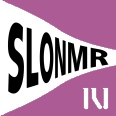Conferences and lectures | Conferences
Frontiers
of Biomolecular NMR
Five
Years of Slovenian NMR Centre February 16-17,
2001, Ljubljana, Slovenia
Invitation
You are cordially invited
to participate in our celebration of five-year anniversary
of NMR center at National Institute of Chemistry. The acquisition
of 600 MHz NMR spectrometer in 1996 represented a milestone
for the NMR research in Slovenia.
The main purpose of this two-day
mini-symposium is to present and review to chemists from industry
as well as from academia the actual possibilities, limitations
and future developments in the use of NMR spectroscopy.
Recently Slovenian NMR center at
NIC was selected by European Commission to be the only 'Center
of Excellence' in Slovenia and this meeting will promote networking
and cooperation with institutions all over EU and Europe.
Mini-symposium will take place
at Hotel Union, Miklosiceva
1, Ljubljana, Slovenia,
February 16-17, 2001.
First
circular pdf
format
Scientific
program
The scientific program is designed
to cover all aspects of the use of NMR spectroscopy on the
systems of biological importance.
The conference will be a two-day
event with invited plenary lecturers, oral presentations and
poster session.
The symposium will be an opportunity
to review our scientific achievements in front of members of
international community and to celebrate the fifth anniversary
of NMR center in Ljubljana.
Main objectives and deliverables
of the symposium:
- To provide a forum for the presentation
and discussion for chemists, biologists and physicists working
in the field of NMR and those who use NMR in their scientific
and research work in academia and in industry,
- Increased networking between
NMR centers inside EU countries and pre-accession countries,
- Contribution to capacity building
through attracting young researchers,
- Increased scope of the centre
and support for economic and social needs of the region,
- Introduction of the most modern
methods of application of NMR spectroscopy in chemistry,
biology and related areas to students and senior scientists.
|

